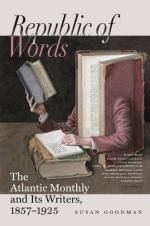The consequence of this will soon be such an enormous collection of forms that they will have to be classified and arranged in vast libraries, as books are now. The time will come when a man who wishes to see any object, natural or artificial, will go to the Imperial, National, or City Stereographic Library and call for its skin or form, as he would for a book at any common library. We do now distinctly propose the creation of a comprehensive and systematic stereographic library, where all men can find the special forms they particularly desire to see as artists, or as scholars, or as mechanics, or in any other capacity. Already a workman has been travelling about the country with stereographic views of furniture, showing his employer’s patterns in this way, and taking orders for them. This is a mere hint of what is coming before long.
Again, we must have special stereographic collections, just as we have professional and other special libraries. And as a means of facilitating the formation of public and private stereographic collections, there must be arranged a comprehensive system of exchanges, so that there may grow up something like a universal currency of these bank-notes, or promises to pay in solid substance, which the sun has engraved for the great Bank of Nature.
To render comparison of similar objects, or of any that we may wish to see side by side, easy, there should be a stereographic metre or fixed standard of focal length for the camera lens, to furnish by its multiples or fractions, if necessary, the scale of distances, and the standard of power in the stereoscope-lens. In this way the eye can make the most rapid and exact comparisons. If the “great elm” and the Cowthorpe oak, if the State-House and St. Peter’s, were taken on the same scale, and looked at with the same magnifying power, we should compare them without the possibility of being misled by those partialities which might tend to make us overrate the indigenous vegetable and the dome of our native Michel Angelo.
The next European war will send us stereographs of battles. It is asserted that a bursting shell can be photographed. The time is perhaps at hand when a flash of light, as sudden and brief as that of the lightning which shows a whirling wheel standing stock still, shall preserve the very instant of the shock of contact of the mighty armies that are even now gathering. The lightning from heaven does actually photograph natural objects on the bodies of those it has just blasted,—so we are told by many witnesses. The lightning of clashing sabres and bayonets may be forced to stereotype itself in a stillness as complete as that of the tumbling tide of Niagara as we see it self-pictured.
We should be led on too far, if we developed our belief as to the transformations to be wrought by this greatest of human triumphs over earthly conditions, the divorce of form and substance. Let our readers fill out a blank check on the future as they like,—we give our indorsement to their imaginations beforehand. We are looking into stereoscopes as pretty toys, and wondering over the photograph as a charming novelty; but before another generation has passed away, it will be recognized that a new epoch in the history of human progress dates from the time when He who




